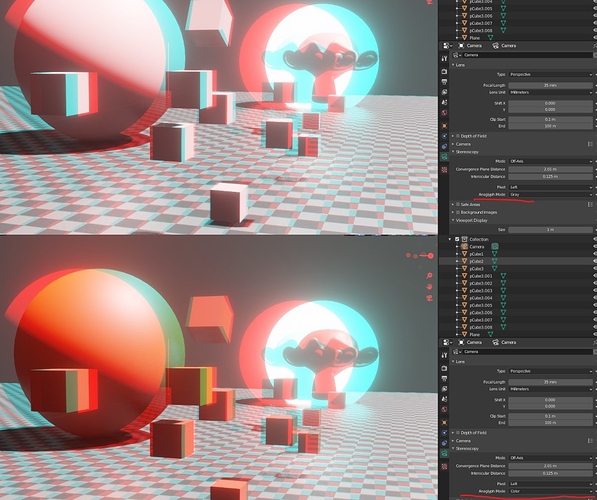I have been trying to change the default anaglyph red-cyan mode when you look through the camera and have stereoscopy on from its default “colored anaglyph” to a “grayscale anaglyph” where the stereoL and stereoR images are converted to greyscale with luma in order to reduce eye strain with certain colors like reds. I was also trying to add other common anaglyph viewing methods such as half color and dubois.
In GPU_viewport_stereo_composite i can make the texture “color_stereo” greyscale using a luma function but can only affect the GB channels since I am using a mask, GPU_color_mask(false, true, true, true) to create the anaglyph effect. I cannot find out how to use shaders on the first pass which i believe is in wm_draw_window offscreen
for (int view = 0; view < 2; view++) {
eStereoViews sview;
if (view == 0) {
sview = STEREO_LEFT_ID;
}
else {
sview = STEREO_RIGHT_ID;
wm_draw_region_stereo_set(bmain, area, region, sview);
}
wm_draw_region_bind(region, view);
ED_region_do_draw(C, region);
wm_draw_region_unbind(region);
}
if (use_viewport) {
GPUViewport *viewport = region->draw_buffer->viewport;
GPU_viewport_stereo_composite(viewport, win->stereo3d_format, win->scene->camera->data);
}
Below is the modified datatoc_gpu_shader_image_overlays_stereo_merge_frag_glsl shader when I call GPU_viewport_stereo_composite. In this function I bind the texture “color_stereo” and with the masking enabled can affect the GB channels. I do not know how to affect the R channel and maintain the red-cyan anaglyph effect. How do I get the separate L/R stereo textures and pass them into the composite shader in order to do operations on them and then do a manual overlay instead of using masking and not being able to affect all the stages? Below is my modified stereo merge shader and it shows what I am trying to do.
const char datatoc_gpu_shader_image_overlays_stereo_merge_frag_glsl[] = {
"#define S3D_DISPLAY_ANAGLYPH 0 \n"
"/* Composite stereo textures */ \n"
"uniform sampler2D imageTexture; \n"
"uniform sampler2D overlayTexture; \n"
//"uniform sampler2D stereoL; \n"
//"uniform sampler2D stereoR; \n"
"uniform int stereoDisplaySettings; \n"
"uniform int anaglyphMethod; \n"
"layout(location = 0) out vec4 imageColor; \n"
"layout(location = 1) out vec4 overlayColor; \n"
"float blendScreen(float base, float blend) \n"
"{ \n"
" return 1.f - ((1.f - base) * (1.f - blend)); \n"
"} \n"
"vec3 blendScreen2(vec3 base, vec3 blend) \n"
"{ \n"
" return vec3(blendScreen(base.r, blend.r), blendScreen(base.g, blend.g), blendScreen(base.b, "
"blend.b)); \n"
"} \n"
"void main() //what I HAVE \n"
"{ \n"
" ivec2 texel = ivec2(gl_FragCoord.xy); \n"
"//vec4 stereoR = already in buffer...?; \n"
"vec4 stereoGB = texelFetch(imageTexture, texel, 0); \n"
"float grayGB = dot(stereoGB.rgb, vec3(.299f, .587f, .114f)); \n"
"if (anaglyphMethod == 0) //color \n"
"imageColor = stereoGB; \n"
"else if (anaglyphMethod == 1) //grayscale \n"
"imageColor = vec4(vec3(grayGB), stereoGB.a); \n"
"overlayColor = vec4(0.f); \n"
"} \n"
"void main() //what i WANT - individual stereoL/R texture access, no masking, manual blending \n"
"{ \n"
" ivec2 texel = ivec2(gl_FragCoord.xy); \n"
"vec4 stereoL = texelFetch(stereoL, texel, 0); \n"
"vec4 stereoR = texelFetch(stereoR, texel, 0); \n"
"if (anaglyphMethod == 0) //color \n"
"{ \n"
"myRed = vec4(stereoL.r, 0.f, 0,f); \n"
"myCyan = vec4(0.f, stereoR.g, stereoR.b); \n"
"} \n"
"else if (anaglyphMethod == 1) //grayscale \n"
"{ \n"
"float grayL = dot(stereoL.rgb, vec3(.299f, .587f, .114f)); \n"
"myRed = vec4(vec3(grayL, 0.f, 0.f), stereoL.a); \n"
"float grayR = dot(stereoR.rgb, vec3(.299f, .587f, .114f)); \n"
"myCyan = vec4(0.f, grayR, grayR, stereoR.a); \n"
"} \n"
"imageColor = blendScreen2(myRed, myCyan); \n"
"overlayColor = vec4(0.f); \n"
"} \n"
};
